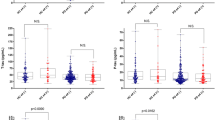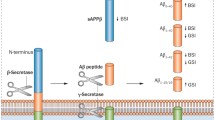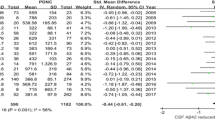Abstract
Many patients with Parkinson’s disease (PD) will develop cognitive impairment. Cross-sectional studies have shown that certain protein levels are altered in the cerebrospinal fluid (CSF) of PD patients with dementia and are thought to represent potential biomarkers of underlying pathogenesis. Recent studies suggest that CSF biomarker levels may be predictive of future risk of cognitive decline in non-demented PD patients. However, the strength of this evidence and difference between specific CSF biomarkers is not well delineated. We therefore performed a systematic review to assess if levels of specific CSF protein biomarkers are predictive of progression to cognitive impairment. Nine articles were identified that met inclusion criteria for the review. Findings from the review suggest a convergence of evidence that a low baseline Aβ42 in the CSF of non-demented PD patients predicts development of cognitive impairment over time. Conversely, there is limited evidence that CSF levels of tau, either total tau or phosphorylated tau, is a useful predictive biomarker. There are mixed results for other CSF biomarkers such as α-synuclein, Neurofilament light chain, and Heart fatty acid-binding protein. Overall the results of this review show that certain CSF biomarkers have better predictive ability to identify PD patients who are at risk for developing cognitive impairment. Given the interest in developing disease-modifying therapies, identifying this group will be important for clinical trials as initiation of therapy prior to the onset of cognitive decline is likely to be more efficacious.

Similar content being viewed by others
References
Aarsland, D., Zaccai, J., & Brayne, C. (2005). A systematic review of prevalence studies of dementia in Parkinson’s disease. Movement Disorders, 20(10), 1255–1263. doi:10.1002/mds.20527.
Aarsland, D., Bronnick, K., Larsen, J. P., Tysnes, O. B., & Alves, G. (2009). Cognitive impairment in incident, untreated Parkinson disease: the Norwegian ParkWest study. Neurology, 72(13), 1121–1126. doi:10.1212/01.wnl.0000338632.00552.cb.
Alves, G., Bronnick, K., Aarsland, D., Blennow, K., Zetterberg, H., Ballard, C., et al. (2010). CSF amyloid-beta and tau proteins, and cognitive performance, in early and untreated Parkinson’s disease: the Norwegian ParkWest study. Journal of Neurology, Neurosurgery, and Psychiatry, 81(10), 1080–1086. doi:10.1136/jnnp.2009.199950.
Alves, G., Lange, J., Blennow, K., Zetterberg, H., Andreasson, U., Forland, M. G., et al. (2014). CSF Abeta42 predicts early-onset dementia in Parkinson disease. Neurology, 82(20), 1784–1790. doi:10.1212/wnl.0000000000000425.
Andersson, M., Wiig, E. H., Minthon, L., & Londos, E. (2007). A quick test for cognitive speed: a measure of cognitive speed in dementia with Lewy bodies. American Journal of Alzheimer’s Disease and Other Dementias, 22(4), 313–318.
Backstrom, D. C., Eriksson Domellof, M., Linder, J., Olsson, B., Ohrfelt, A., Trupp, M., et al. (2015). Cerebrospinal fluid patterns and the risk of future dementia in early, incident Parkinson disease. JAMA Neurology. doi:10.1001/jamaneurol.2015.1449.
Benedict, R.H. (1997). Brief visuospatial memory test--revised: professional manual: PAR.
Benton, A. L., Hamsher, K., Varney, N. R., & Spreen, O. (1983). Judgment of line orientation. New York: Oxford University Press.
Bjerke, M., Portelius, E., Minthon, L., Wallin, A., Anckarsäter, H., Anckarsäter, R., et al. (2010). Confounding factors influencing amyloid beta concentration in cerebrospinal fluid. International Journal of Alzheimer’s disease, 2010.
Blennow, K., & Hampel, H. (2003). CSF markers for incipient Alzheimer’s disease. The Lancet Neurology, 2(10), 605–613.
Blennow, K., Hampel, H., & Zetterberg, H. (2014). Biomarkers in amyloid-β immunotherapy trials in Alzheimer’s disease. Neuropsychopharmacology, 39(1), 189–201.
Bowie, C. R., & Harvey, P. D. (2006). Administration and interpretation of the trail making test. Nature Protocols, 1(5), 2277–2281.
Broeders, M., de Bie, R. M., Velseboer, D. C., Speelman, J. D., Muslimovic, D., & Schmand, B. (2013a). Evolution of mild cognitive impairment in Parkinson disease. Neurology, 81(4), 346–352. doi:10.1212/WNL.0b013e31829c5c86.
Broeders, M., Velseboer, D. C., de Bie, R., Speelman, J. D., Muslimovic, D., Post, B., et al. (2013b). Cognitive change in newly-diagnosed patients with Parkinson’s disease: a 5-year follow-up study. Journal of International Neuropsychological Society, 19(6), 695–708. doi:10.1017/s1355617713000295.
Butterfield, D. A., Drake, J., Pocernich, C., & Castegna, A. (2001). Evidence of oxidative damage in Alzheimer’s disease brain: central role for amyloid β-peptide. Trends in Molecular Medicine, 7(12), 548–554.
Caviness, J. N., Driver-Dunckley, E., Connor, D. J., Sabbagh, M. N., Hentz, J. G., Noble, B., et al. (2007). Defining mild cognitive impairment in Parkinson’s disease. Movement Disorders, 22(9), 1272–1277. doi:10.1002/mds.21453.
Compta, Y., Marti, M. J., Ibarretxe-Bilbao, N., Junque, C., Valldeoriola, F., Munoz, E., et al. (2009). Cerebrospinal tau, phospho-tau, and beta-amyloid and neuropsychological functions in Parkinson’s disease. Movement Disorders, 24(15), 2203–2210. doi:10.1002/mds.22594.
Compta, Y., Pereira, J. B., Rios, J., Ibarretxe-Bilbao, N., Junque, C., Bargallo, N., et al. (2013). Combined dementia-risk biomarkers in Parkinson’s disease: a prospective longitudinal study. Parkinsonism & Related Disorders, 19(8), 717–724. doi:10.1016/j.parkreldis.2013.03.009.
DeKosky, S. T., & Scheff, S. W. (1990). Synapse loss in frontal cortex biopsies in Alzheimer’s disease: correlation with cognitive severity. Annals of Neurology, 27(5), 457–464.
Diniz, B. S., Pinto Junior, J. A., & Forlenza, O. V. (2008). Do CSF total tau, phosphorylated tau, and beta-amyloid 42 help to predict progression of mild cognitive impairment to Alzheimer’s disease? A systematic review and meta-analysis of the literature. The World Journal of Biological Psychiatry, 9(3), 172–182. doi:10.1080/15622970701535502.
Donnelly, K., Donnelly, J., Lichter, D., & Hershey, L. (1995). Longitudinal assessment of verbal and visual memory in Parkinson’s disease patients. Archives of Clinical Neuropsychology, 10(4), 322–323.
Doody, R. S., Thomas, R. G., Farlow, M., Iwatsubo, T., Vellas, B., Joffe, S., et al. (2014). Phase 3 trials of solanezumab for mild-to-moderate Alzheimer’s disease. New England Journal of Medicine, 370(4), 311–321.
Emre, M., Aarsland, D., Brown, R., Burn, D. J., Duyckaerts, C., Mizuno, Y., et al. (2007). Clinical diagnostic criteria for dementia associated with Parkinson’s disease. Movement Disorders, 22(12), 1689–1707. doi:10.1002/mds.21507. quiz 1837.
Ewers, M., Walsh, C., Trojanowski, J. Q., Shaw, L. M., Petersen, R. C., Jack, C. R., Jr., et al. (2012). Prediction of conversion from mild cognitive impairment to Alzheimer’s disease dementia based upon biomarkers and neuropsychological test performance. Neurobiology of Aging, 33(7), 1203–1214. doi:10.1016/j.neurobiolaging.2010.10.019.
Fischer, P., Jungwirth, S., Zehetmayer, S., Weissgram, S., Hoenigschnabl, S., Gelpi, E., et al. (2007). Conversion from subtypes of mild cognitive impairment to Alzheimer dementia. Neurology, 68(4), 288–291.
Folstein, M. F., Folstein, S. E., & McHugh, P. R. (1975). “Mini-mental state”. A practical method for grading the cognitive state of patients for the clinician. Journal of Psychiatric Research, 12(3), 189–198.
Fournier, N., Geoffroy, M., & Deshusses, J. (1978). Purification and characterization of a long chain, fatty-acid-binding protein supplying the mitochondrial β-oxidative system in the heart. Biochimica et Biophysica Acta (BBA)-Protein Structure, 533(2), 457–464.
Gill, D. J., Freshman, A., Blender, J. A., & Ravina, B. (2008). The Montreal cognitive assessment as a screening tool for cognitive impairment in Parkinson’s disease. Movement Disorders, 23(7), 1043–1046.
Golden, C. (1978). Stroop colour and word test. AGE, 15, 90.
Groth-Marnat, G. (2009). Handbook of psychological assessment: Wiley.
Hall, S., Ohrfelt, A., Constantinescu, R., Andreasson, U., Surova, Y., Bostrom, F., et al. (2012). Accuracy of a panel of 5 cerebrospinal fluid biomarkers in the differential diagnosis of patients with dementia and/or parkinsonian disorders. Archives of Neurology, 69(11), 1445–1452. doi:10.1001/archneurol.2012.1654.
Hall, S., Surova, Y., Ohrfelt, A., Zetterberg, H., Lindqvist, D., & Hansson, O. (2015). CSF biomarkers and clinical progression of Parkinson disease. Neurology, 84(1), 57–63. doi:10.1212/wnl.0000000000001098.
Halliday, G. M., Leverenz, J. B., Schneider, J. S., & Adler, C. H. (2014). The neurobiological basis of cognitive impairment in Parkinson’s disease. Movement Disorders, 29(5), 634–650. doi:10.1002/mds.25857.
Heaton, R. K. (1993). Wisconsin card sorting test: computer version 2. Odessa: Psychological Assessment Resources.
Hely, M. A., Reid, W. G., Adena, M. A., Halliday, G. M., & Morris, J. G. (2008). The Sydney multicenter study of Parkinson’s disease: the inevitability of dementia at 20 years. Movement Disorders, 23(6), 837–844. doi:10.1002/mds.21956.
Irwin, D. J., Lee, V. M., & Trojanowski, J. Q. (2013). Parkinson’s disease dementia: convergence of alpha-synuclein, tau and amyloid-beta pathologies. Nature Reviews Neuroscience, 14(9), 626–636. doi:10.1038/nrn3549.
Ivnik, R. J., Smith, G. E., Lucas, J. A., Tangalos, E. G., Kokmen, E., & Petersen, R. C. (1997). Free and cued selective reminding test: MOANS norms. Journal of Clinical and Experimental Neuropsychology, 19(5), 676–691.
Johnson-Greene, D. (2004). Dementia rating scale-2 (DRS-2): by P.J. Jurica, C.L. Leitten, and S. Mattis: psychological Assessment Resources, 2001. Archives of Clinical Neuropsychology, 19(1), 145–147. doi:10.1016/j.acn.2003.07.003.
Kang, J. H., Irwin, D. J., Chen-Plotkin, A. S., Siderowf, A., Caspell, C., Coffey, C. S., et al. (2013). Association of cerebrospinal fluid beta-amyloid 1–42, T-tau, P-tau181, and alpha-synuclein levels with clinical features of drug-naive patients with early Parkinson disease. JAMA Neurology, 70(10), 1277–1287. doi:10.1001/jamaneurol.2013.3861.
Kaplan, E. F., Goodglass, H., & Weintraub, S. (1983). The Boston naming test: experimental edition. Boston: Kaplan & Goodglass (2nd ed.). Philadelphia: Lea & Febinger.
Kehagia, A. A., Barker, R. A., & Robbins, T. W. (2010). Neuropsychological and clinical heterogeneity of cognitive impairment and dementia in patients with Parkinson’s disease. Lancet Neurology, 9(12), 1200–1213. doi:10.1016/s1474-4422(10)70212-x.
Kehagia, A. A., Barker, R. A., & Robbins, T. W. (2013). Cognitive impairment in Parkinson’s disease: the dual syndrome hypothesis. Neurodegenerative Diseases, 11(2), 79–92. doi:10.1159/000341998.
Leverenz, J. B., Watson, G. S., Shofer, J., Zabetian, C. P., Zhang, J., & Montine, T. J. (2011). Cerebrospinal fluid biomarkers and cognitive performance in non-demented patients with Parkinson’s disease. Parkinsonism & Related Disorders, 17(1), 61–64. doi:10.1016/j.parkreldis.2010.10.003.
Lin, C.-H., & Wu, R.-M. (2015). Biomarkers of cognitive decline in Parkinson’s disease. Parkinsonism & Related Disorders, 21(5), 431–443.
Litvan, I., Bhatia, K. P., Burn, D. J., Goetz, C. G., Lang, A. E., McKeith, I., et al. (2003). SIC Task Force appraisal of clinical diagnostic criteria for parkinsonian disorders. Movement disorders, 18(5), 467–486.
Litvan, I., Goldman, J. G., Troster, A. I., Schmand, B. A., Weintraub, D., Petersen, R. C., et al. (2012). Diagnostic criteria for mild cognitive impairment in Parkinson’s disease: movement disorder society task force guidelines. Movement Disorders, 27(3), 349–356. doi:10.1002/mds.24893.
Liu, C., Cholerton, B., Shi, M., Ginghina, C., Cain, K. C., Auinger, P., et al. (2015). CSF tau and tau/Abeta42 predict cognitive decline in Parkinson’s disease. Parkinsonism & Related Disorders, 21(3), 271–276. doi:10.1016/j.parkreldis.2014.12.027.
Llebaria, G., Pagonabarraga, J., Kulisevsky, J., Garcia-Sanchez, C., Pascual-Sedano, B., Gironell, A., et al. (2008). Cut-off score of the Mattis dementia rating scale for screening dementia in Parkinson’s disease. Movement Disorders, 23(11), 1546–1550. doi:10.1002/mds.22173.
Lopes, M., Brucki, S. M. D., Giampaoli, V., & Mansur, L. L. (2009). Semantic verbal fluency test in dementia. Dementia & Neuropsychologia, 3, 315–320.
Mattson, M. P. (2004). Pathways towards and away from Alzheimer’s disease. Nature, 430(7000), 631–639.
Mitrushina, M., Boone, K.B., Razani, J., & D’Elia, L.F. (2005). Handbook of normative data for neuropsychological assessment: Oxford University Press.
Moher, D., Liberati, A., Tetzlaff, J., & Altman, D. G. (2009). Preferred reporting items for systematic reviews and meta-analyses: the PRISMA statement. Journal of Clinical Epidemiology, 62(10), 1006–1012. doi:10.1016/j.jclinepi.2009.06.005.
Mohs, R., Rosen, W., & Davis, K. (1983). The Alzheimer’s disease assessment scale: an instrument for assessing treatment efficacy. Psychopharmacology Bulletin, 19(3), 448.
Mollenhauer, B., Bibl, M., Wiltfang, J., Steinacker, P., Ciesielczyk, B., Neubert, K., et al. (2006). Total tau protein, phosphorylated tau (181p) protein, beta-amyloid(1–42), and beta-amyloid(1–40) in cerebrospinal fluid of patients with dementia with Lewy bodies. Clinical Chemistry and Laboratory Medicine, 44(2), 192–195. doi:10.1515/cclm.2006.035.
Mollenhauer, B., Rochester, L., Chen-Plotkin, A., & Brooks, D. (2014). What can biomarkers tell us about cognition in Parkinson’s disease? Movement Disorders, 29(5), 622–633. doi:10.1002/mds.25846.
Mollenhauer, B., Parnetti, L., Rektorova, I., Kramberger, M. G., Pikkarainen, M., Schulz‐Schaeffer, W. J., et al. (2015). Biological confounders for the values of cerebrospinal fluid proteins in Parkinson’s disease and related disorders. Journal of Neurochemistry. doi:10.1111/jnc.13390.
Montine, T. J., Shi, M., Quinn, J. F., Peskind, E. R., Craft, S., Ginghina, C., et al. (2010). CSF Abeta(42) and tau in Parkinson’s disease with cognitive impairment. Movement Disorders, 25(15), 2682–2685. doi:10.1002/mds.23287.
Morris, J. C., Aisen, P. S., Bateman, R. J., Benzinger, T. L., Cairns, N. J., Fagan, A. M., et al. (2012). Developing an international network for Alzheimer’s research: the dominantly inherited Alzheimer network. Clinical Investigation, 2(10), 975–984.
Motter, N., Vigo‐Pelfrey, C., Kholodenko, D., Barbour, R., Johnson‐Wood, K., Galasko, D., et al. (1995). Reduction of β‐amyloid peptide42 in the cerebrospinal fluid of patients with Alzheimer’s disease. Annals of Neurology, 38(4), 643–648.
Nombela, C., Rowe, J. B., Winder-Rhodes, S. E., Hampshire, A., Owen, A. M., Breen, D. P., et al. (2014). Genetic impact on cognition and brain function in newly diagnosed Parkinson’s disease: ICICLE-PD study. Brain, 137(Pt 10), 2743–2758. doi:10.1093/brain/awu201.
Parnetti, L., Tiraboschi, P., Lanari, A., Peducci, M., Padiglioni, C., D’Amore, C., et al. (2008). Cerebrospinal fluid biomarkers in Parkinson’s disease with dementia and dementia with Lewy bodies. Biological Psychiatry, 64(10), 850–855. doi:10.1016/j.biopsych.2008.02.016.
Parnetti, L., Farotti, L., Eusebi, P., Chiasserini, D., De Carlo, C., Giannandrea, D., et al. (2014). Differential role of CSF alpha-synuclein species, tau, and Abeta42 in Parkinson’s Disease. Frontiers in Aging Neuroscience, 6, 53. doi:10.3389/fnagi.2014.00053.
Rafii, M. S., & Aisen, P. S. (2015). Advances in Alzheimer’s disease drug development. BMC Medicine, 13, 62. doi:10.1186/s12916-015-0297-4.
Randall, K. D., & Kerns, K. A. (2011). Selective reminding test. In Encyclopedia of Clinical Neuropsychology (pp. 2235–2237): Springer.
Redding, G. M., & Gerjets, D. A. (1977). Stroop effect: interference and facilitation with verbal and manual responses. Perceptual and Motor Skills, 45(1), 11–17.
Reid, W. G., Hely, M. A., Morris, J. G., Loy, C., & Halliday, G. M. (2011). Dementia in Parkinson’s disease: a 20-year neuropsychological study (Sydney Multicentre Study). Journal of Neurology, Neurosurgery, and Psychiatry, 82(9), 1033–1037. doi:10.1136/jnnp.2010.232678.
Robbins, T. W., & Cools, R. (2014). Cognitive deficits in Parkinson’s disease: a cognitive neuroscience perspective. Movement Disorders, 29(5), 597–607. doi:10.1002/mds.25853.
Scherling, C. S., Hall, T., Berisha, F., Klepac, K., Karydas, A., Coppola, G., et al. (2014). Cerebrospinal fluid neurofilament concentration reflects disease severity in frontotemporal degeneration. Annals of Neurology, 75(1), 116–126.
Schmidt, M. (1996). Rey auditory verbal learning test: a handbook. Los Angeles: Western Psychological Services.
Sebaldt, R., Dalziel, W., Massoud, F., Tanguay, A., Ward, R., Thabane, L., et al. (2009). Detection of cognitive impairment and dementia using the animal fluency test: the DECIDE study. The Canadian Journal of Neurological Sciences, 36(05), 599–604.
Shaw, L. M., Vanderstichele, H., Knapik‐Czajka, M., Clark, C. M., Aisen, P. S., Petersen, R. C., et al. (2009). Cerebrospinal fluid biomarker signature in Alzheimer’s disease neuroimaging initiative subjects. Annals of Neurology, 65(4), 403–413.
Siderowf, A., Xie, S. X., Hurtig, H., Weintraub, D., Duda, J., Chen-Plotkin, A., et al. (2010). CSF amyloid {beta} 1–42 predicts cognitive decline in Parkinson disease. Neurology, 75(12), 1055–1061. doi:10.1212/WNL.0b013e3181f39a78.
Smith, A. (2000). Symbol digit modalities test: SDMT: Testzentrale.
Sperling, R., Donohue, M., & Aisen, P. (2012). The A4 trial: anti-amyloid treatment of asymptomatic Alzheimer’s disease. Alzheimer’s & Dementia, 8(4), 425–P426.
Steering, D. (1989). DATATOP: a multicenter controlled clinical trial in early Parkinson’s disease. Archives of Neurology, 46(10), 1052–1060.
Stewart, T., Liu, C., Ginghina, C., Cain, K. C., Auinger, P., Cholerton, B., et al. (2014). Cerebrospinal fluid alpha-synuclein predicts cognitive decline in Parkinson disease progression in the DATATOP cohort. [Randomized Controlled Trial Research Support, N.I.H., Extramural]. The American Journal of Pathology, 184(4), 966–975. doi:10.1016/j.ajpath.2013.12.007.
Strozyk, D., Blennow, K., White, L., & Launer, L. (2003). CSF Aβ 42 levels correlate with amyloid-neuropathology in a population-based autopsy study. Neurology, 60(4), 652–656.
Tachibana, H. (2013). Cognitive impairment in Parkinson’s disease. Seishin Shinkeigaku Zasshi, 115(11), 1142–1149.
Tariot, P. N., Ho, C., Langlois, C., Reiman, E. M., Lopera, F., Langbaum, J. B., et al. (2014). The Alzheimer’s prevention initiative. Alzheimer’s & Dementia: The Journal of the Alzheimer’s Association, 10(4), P247.
Terrelonge, M., Jr., Marder, K. S., Weintraub, D., & Alcalay, R. N. (2015). CSF beta-amyloid 1–42 predicts progression to cognitive impairment in newly diagnosed Parkinson disease. Journal of Molecular Neuroscience. doi:10.1007/s12031-015-0647-x.
Tombaugh, T. N., Kozak, J., & Rees, L. (1999). Normative data stratified by age and education for two measures of verbal fluency: FAS and animal naming. Archives of Clinical Neuropsychology, 14(2), 167–177.
Vanderploeg, R. D., Schinka, J. A., Jones, T., Small, B. J., Borenstein Graves, A., & Mortimer, J. A. (2000). Elderly norms for the hopkins verbal learning test-revised. The Clinical Neuropsychologist, 14(3), 318–324.
Vranova, H. P., Henykova, E., Kaiserova, M., Mensikova, K., Vastik, M., Mares, J., et al. (2014). Tau protein, beta-amyloid(1)(−)(4)(2) and clusterin CSF levels in the differential diagnosis of Parkinsonian syndrome with dementia. Journal of Neurological Sciences, 343(1–2), 120–124. doi:10.1016/j.jns.2014.05.052.
Wada-Isoe, K., Imamura, K., Kitamaya, M., Kowa, H., & Nakashima, K. (2008). Serum heart-fatty acid binding protein levels in patients with Lewy body disease. Journal of the Neurological Sciences, 266(1), 20–24.
Warrington, E. K., & James, M. (1991). The visual object and space perception battery. Bury St Edmunds: Thames Valley Test Company.
Williams-Gray, C. H., Evans, J. R., Goris, A., Foltynie, T., Ban, M., Robbins, T. W., et al. (2009). The distinct cognitive syndromes of Parkinson’s disease: 5 year follow-up of the CamPaIGN cohort. Brain, 132(Pt 11), 2958–2969. doi:10.1093/brain/awp245.
Woods, S. P., Delis, D. C., Scott, J. C., Kramer, J. H., & Holdnack, J. A. (2006). The California verbal learning test–second edition: test-retest reliability, practice effects, and reliable change indices for the standard and alternate forms. Archives of Clinical Neuropsychology, 21(5), 413–420.
Yarnall, A. J., Breen, D. P., Duncan, G. W., Khoo, T. K., Coleman, S. Y., Firbank, M. J., et al. (2014). Characterizing mild cognitive impairment in incident Parkinson disease: the ICICLE-PD study. Neurology, 82(4), 308–316. doi:10.1212/wnl.0000000000000066.
Zhang, J., Mattison, H. A., Liu, C., Ginghina, C., Auinger, P., McDermott, M. P., et al. (2013). Longitudinal assessment of tau and amyloid beta in cerebrospinal fluid of Parkinson disease. Acta Neuropathologica, 126(5), 671–682. doi:10.1007/s00401-013-1121-x.
Acknowledgments
This research was supported by grants from the NIH/NIA (AG047366), NIH/NIAAA (AA023165), NIH/NINDS (NS075097, NS091461, NS086085, and NS071675), and Michael J. Fox Foundation for Parkinson’s disease Research.
Author information
Authors and Affiliations
Corresponding author
Rights and permissions
About this article
Cite this article
Leaver, K., Poston, K.L. Do CSF Biomarkers Predict Progression to Cognitive Impairment in Parkinson’s disease patients? A Systematic Review. Neuropsychol Rev 25, 411–423 (2015). https://doi.org/10.1007/s11065-015-9307-8
Received:
Accepted:
Published:
Issue Date:
DOI: https://doi.org/10.1007/s11065-015-9307-8




